
Anostostomatidae is a family of insects in the order Orthoptera, widely distributed in the southern hemisphere. It is named Mimnermidae or Henicidae in some taxonomies, and common names include king crickets in South Africa and wētā in New Zealand. Prominent members include the Parktown prawn of South Africa, and the giant wētā of New Zealand. The distribution of this family reflects a common ancestry before the fragmenting of Gondwana.

The subfamily Pseudophyllinae contains numerous species in the family Tettigoniidae, the katydids or bush crickets. Sometimes called "true katydids", together with the crickets of suborder Ensifera, they form part of the insect order Orthoptera which also contains grasshoppers.

The Phaneropterinae, the sickle-bearing bush crickets or leaf katydids, are a subfamily of insects within the family Tettigoniidae. Nearly 2,060 species in 85 genera throughout the world are known. They are also known as false katydids or round-headed katydids.

Hexacentrus is the type genus of bush-crickets in the subfamily Hexacentrinae. Most species of this genus occur in Southeast Asia and in Africa.

Mecopodinae, the long-legged katydids, are a subfamily of bush crickets found in western South America, sub-Saharan Africa, and Asia. In Asia, the distribution includes India, Indochina, Japan, the Philippines, and Malesia to Papua New Guinea and Australasia, including many Pacific islands.

The Copiphorini are a tribe of bush crickets or katydids in the family Tettigoniidae. Previously considered a subfamily, they are now placed in the subfamily Conocephalinae. Like some other members of Conocephalinae, they are known as coneheads, grasshopper-like insects with an extended, cone-shaped projection on their heads that juts forward in front of the base of the antennae.

Conocephalinae, meaning "conical head", is an Orthopteran subfamily in the family Tettigoniidae.

Agraeciini is a large tribe of bush crickets or katydids in the conehead subfamily, Conocephalinae.

The Listroscelidinae are a subfamily of the Tettigoniidae found in the Americas, Madagascar, and Australia.

Pentacentrinae is a subfamily of crickets in the family Gryllidae. Sometimes known as 'Silent Litter Crickets', they occur in tropical Asia, Africa and the Americas.
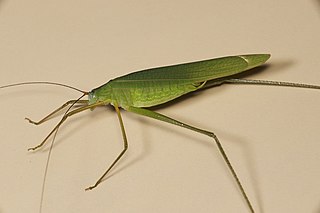
Elimaea is a large genus within Tettigoniidae, the bush cricket or katydid family. Species in this genus are found in India, southern China, Indo-China and Malesia.
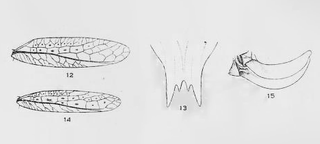
Stictophaula is a genus of Asian Tettigoniidae of the tribe Holochlorini within the subfamily Phaneropterinae. They are found in Indo-China, China, and Malesia.
Thaumaspis is a genus of Asian bush crickets belonging to the tribe Meconematini in the subfamily Meconematinae.
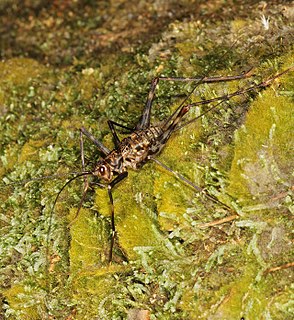
The Phalangopsidae are a recently reconstituted family of crickets, based on the type genus PhalangopsisServille, 1831 from South America. Priority for family-group names based on this genus dates from Blanchard's "Phalangopsites".
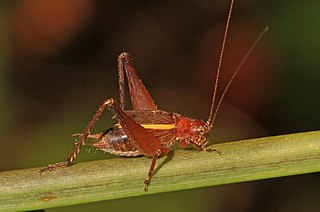
Hapithini is a tribe of crickets in the subfamily Hapithinae. There are about 12 genera and more than 260 described species: found in Central and South America.
Aphonomorphini is a tribe of crickets in the subfamily Hapithinae. There are about 6 genera and more than 90 described species in Aphonomorphini.
Asarcogryllacris is an Asian genus of Orthopterans, sometimes known as 'leaf-folding crickets': in the subfamily Gryllacridinae and tribe Asarcogryllacridini. Species have been recorded from Indochina and west Malesia.
Phryganogryllacris is an Asian genus of Orthopterans, sometimes known as 'leaf-folding crickets', in the subfamily Gryllacridinae and tribe Phryganogryllacridini. Species have been recorded from: India, China, Indochina, Malesia, through to New Guinea.
Metriogryllacris is a genus of Orthopterans, sometimes known as 'leaf-folding crickets' in the subfamily Gryllacridinae, tribe Gryllacridini and the genus group Metriogryllacrae Cadena-Castañeda, 2019. The recorded distribution is currently: Japan, Korea, China, Vietnam and Java and Sulawesi in Malesia.
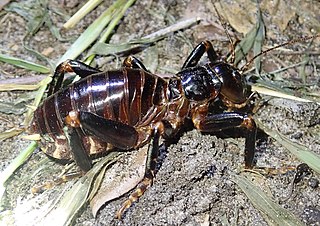
Stenopelmatinae is a subfamily of in the family Stenopelmatidae. There are about 7 genera and more than 50 described species in Stenopelmatinae.
















